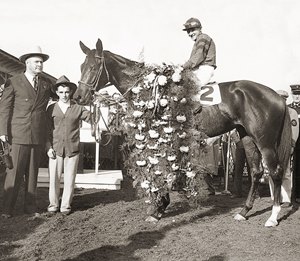BH 100: Twilight Tear


This feature originally appeared in the October 8, 2016 issue of BloodHorse.
The United States of 1944 was a country three years mired in a world war, and every aspect of the American way of life had been affected, requiring sacrifices on a nationwide scale. Staples such as gasoline, sugar, butter, coffee, and meat were in short supply. The war also transformed the role of women as they assumed tasks heretofore relegated to men. Rosie the Riveter—denim sleeves rolled up, muscles flexed, and a “we can do it” attitude—had become as important a symbol as Uncle Sam.
Sports too made sacrifices. Due to a ban on transportation, horse racing was curtailed and meets were consolidated in cities that were transportation hubs: Chicago, New York, etc.
The Blood-Horse also found itself altering the way it had done business since its founding in 1916. The July 29, 1944, issue of the magazine was prefaced with a message to the readers from editor Joe Estes: “In common with other publications The Blood-Horse is posed a problem by the wartime restrictions on the use of paper. It has kept the number of pages lower than it would have ordinarily done and has begun to use a paper stock of lower weight. There now appears a possibility that we may have to decline to accept new subscriptions, and a further possibility that we shall have to restrict, in some degree, the sale of advertising space during the months ahead. At any rate we must cut corners.”
While the war might have to a great degree limited racing as it had been and the coverage of important racing staples became bare-boned meat and potatoes, what it did not affect was the quality of the horses that lined up at the tracks to deliver an escape to a nation harried by the dangers faced in battlefields across Europe and the Pacific, and, in many cases, to raise huge sums of money for war relief and the vital services provided by the Red Cross.
Calumet Farm, which was on the fast track to icon status, had a pair of classic-seeking 3-year-olds, the chestnut colt Pensive and the dark bay filly Twilight Tear, whose prowess contributed to that aspect of the war effort.
Co-champion juvenile filly of 1943, Twilight Tear received her first 1944 Blood-Horse coverage in the March 18 issue and it was less than championship worthy: “First 1944 start for Calumet Farm’s Twilight Tear, one of the best of the 2-year-old fillies last season, found her third, beaten two lengths behind the good sprinters Mettlesome and Adulator. By the scale she was giving the winner six pounds, the second horse eight.”
Reading between the lines, the blurb doesn’t reveal that the race trainer Ben Jones chose for Twilight Tear’s debut was the Leap Year Handicap against older male sprinters who had some pretty good credentials of their own. If this stern test were to judge her mettle, the 16-hand dynamo was not found wanting.
While the farm’s Pensive took early honors with a classic victory in the Kentucky Derby, Twilight Tear was blazing her own path to stardom, firing off four straight victories. She won the Pimlico Oaks a few days before his victory in the Preakness Stakes and while Twilight Tear added the Acorn Stakes and Coaching Club American Oaks at Belmont, Pensive came up a half-length second in the Belmont Stakes.
Thus, the question on the minds of racing fans became which Calumet star was better. The answer came twice at Arlington Park.
Somewhere after the Belmont, the flame in Pensive’s pilot light went out and he went from boil to simmer, losing not only an allowance prep for the Arlington Classic but the Classic as well to his stablemate. With those victories Twilight Tear wrested the potential Horse of the Year buzz from the rest of the sophomore class.
A three-quarter-length loss to Vienna—to whom she was giving 12 pounds over 10 furlongs—in the Alabama Stakes ended her 11-race win streak. However, the loss did little to tarnish her valkyrie reputation that had racing reporters mentioning her in the same breath as the great fillies and mares of the past: Beldame, Imp, and Regret.
Another leading contender for Horse of the Year honors was Greentree Farm’s 5-year-old horse Devil Diver, who had been a mark of consistency among the handicap division. The Blood-Horse reported his winning performances in such staples of the handicap ranks as the Toboggan, Metropolitan, and Manhattan handicaps as well as the Whitney Stakes.
The eighth running of the Pimlico Special became the crucible for determining the year-end crown. Its seven previous editions certainly had Horse of the Year implications: War Admiral (1937), Seabiscuit in the “race of the generation” with War Admiral (1938), Challedon (1939-40), and Whirlaway (1942) all ran in it.
A $25,000 invitational winner-take-all race, the Special attracted only one other horse, Christiana Stable’s Megogo, willing—or foolish—enough to join the fray. Carrying 117 pounds to the older Devil Diver’s 126, Twilight Tear and jockey Doug Dodson had little trouble with her Greentree foe ridden by Eddie Arcaro. She won by six lengths, matching Seabiscuit’s stakes record for the 1 3/16 miles, with Devil Diver 10 lengths ahead of Megogo.
At year’s end Twilight Tear was named champion 3-year-old filly and became the first filly to earn a Horse of the Year title since championships became an official part of the racing lexicon in 1936.
Twilight Tear aided the war effort not only on the tracks of America but in the air over Europe. Though not reported in the pages of The Blood-Horse, while Twilight Tear raced toward a Horse of the Year title, a Mustang airplane rolled off an assembly line in a California factory. Named after the 1944 Horse of the Year, the Twilight Tear flew 35 combat missions over Europe and shot down three enemy aircraft.
